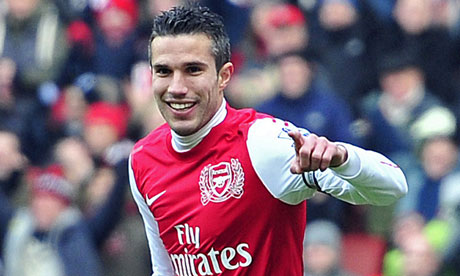With Arsenal captain Robin van Persie
certain to sign for Manchester United, the balance of power in the
English Premier League shifts again towards the country's northwest.
Despite Arsenal's best efforts to provide him with support in the
form of the
deepest squad of his tenure at the Emirates, van Persie's quest
for self-actualisation through silverware now continues at Old
Trafford.
Manchester United supporters will be
happy with the purchase: it cements their position as a destination
club, goals are always welcome and the transfer fee – despite
reaching a rumoured ₤24
million – is quite justifiable should the van Persie provide
even three years of quality play.
He will (likely) start at the pointy
end of Sir Alex Ferguson's preferred one-striker formations, the
4-4-1-1 or 4-2-3-1. This means, despite
ink suggesting other centre-forwards will be marginalised, it
seems far more likely that fellow new signing Shinji Kagawa or
established wide men like Ashley Young will be most affected. With
Kagawa, Tom Cleverley, youngster Nick Powell, Rooney and Young all
probably best employed behind the striker, pessimists suggest the
club has too many players in competition for one role.
That Ferguson purchased Kagawa this
summer, Young last year, as well as advancing Cleverley, suggests the
United manager favours a mobile, multifocal attack where numerous
players are able to threaten opposing defences. This flexibility
fits
with his formation preference, which ostensibly affords better
support for an creaking central midfield from a mobile forward corps.
When attacking, the mosquito-fleet forwards can then run at defences
rather than depending upon glamour balls to isolated target men.
United's best play this century came
from 2007-2009 with a fluid 4-3-3. When they effectively replaced
the versatile Cristiano Ronaldo with the more orthodox Dimitar
Berbatov, an element of that interoperability was lost.
Although he was hardly
a failure, it was perhaps a sense of tactical straightforwardness
which led to Berbatov's purchase in 2008. In spite of a reported ₤30
million price tag, Berbatov was rarely deployed in big matches and
almost never by himself: his lack of acumen and (apparently)
inclination reducing his effectiveness in the critical poacher's
role. Berbatov's languor and uncanny lead-up play has always been
suited best to the 4-4-2. As United have attempted to increase their
flexibility, Berbatov has become a bench fixture. van Persie is not
nearly so limited.
Although sometimes very effective –
c.f. Martin O'Neill's success at Aston Villa and Sunderland – it is
tactical naïveté
to suggest that “defenders defend, attackers attack and midfielders
link the two”. When competing against the best clubs in the world,
such simplicity is quickly rendered obsolete, and the flat, age-old
4-4-2 formation is now utilised less
and less in truly elite teams.
 |
| Courtesy: guardian.co.uk |
The lessons taught by Champions League
drubbings against Barcelona may have been learnt. Messi, Xavi and
Iniesta, the three most important players in what was popularly
acknowledged as the best team in recent memory, all prefer to operate
centrally. Of course there are differences and these changes may
just be a stall until Ferguson develops or acquires a supertalented
central hub. Ferguson may opt to shuffle – no-one really knows
what the old fox has in mind: signing Robin van Persie could simply
be the managerial equivalent of a mid-life crisis sports car.
However, optimists could perhaps see
him as
the final step in United's journey towards fully embracing a more
fluid tactical system.

No comments:
Post a Comment